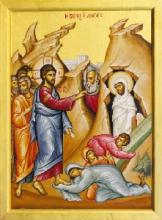
This day, along with Palm Sunday, occupies a special position between Lent and Holy Week. Following the forty days of penitence which have just ended, and immediately before the days of darkness and mourning which are to follow in the week of the Passion, there come two days of joy and triumph on which the Church keeps festival. The Saturday before Palm Sunday celebrates the raising of Lazarus at Bethany (John 11:1-46). This miracle is performed by Christ as a reassurance to His disciples before the coming Passion: they are to understand that, though He suffers and dies, yet He is Lord and Victor over death. The resurrection of Lazarus is a prophecy in the form of an action. It foreshadows Christ's own Resurrection eight days later, and at the same time it anticipates the resurrection of all the righteous on the Last Day: Lazarus is 'the saving first-fruits of the regeneration of the world'.
As the liturgical texts emphasize, the miracle at Bethany reveals the two natures of Christ the God-man. Christ asks where Lazarus is laid and weeps for him, and so He shows the fullness of His manhood, involving as it does human ignorance and genuine grief for a beloved friend. Then, disclosing the fullness of His divine power, Christ raises Lazarus from the dead, even though his corpse has already begun to decompose and stink. This double fullness of the Lord's divinity and His humanity is to be kept in view throughout Holy Week and above all on Great Friday. On the Cross we see a genuinely human agony, both physical and mental, but we see more than this: we see not only suffering man, but suffering God.
- From The Lenten Triodion, "The Meaning of the Great Fast", Metropolitan Kallistos (Ware)
